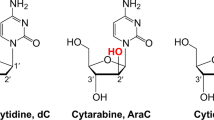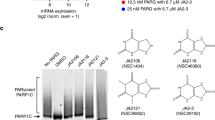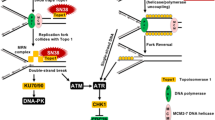Abstract
A major clinical problem in the use of cisplatin to treat cancers is tumor resistance. DNA polymerase η (Pol-η) is a crucial polymerase that allows cancer cells to cope with the cisplatin–DNA adducts that are formed during chemotherapy. We present here a structure of human Pol-η inserting deoxycytidine triphosphate (dCTP) opposite a cisplatin intrastrand cross-link (PtGpG). We show that the specificity of human Pol-η for PtGpG derives from an active site that is open to permit Watson-Crick geometry of the nascent PtGpG-dCTP base pair and to accommodate the lesion without steric hindrance. This specificity is augmented by the residues Gln38 and Ser62, which interact with PtGpG, and Arg61, which interacts with the incoming dCTP. Collectively, the structure provides a basis for understanding how Pol-η in human cells can tolerate the DNA damage caused by cisplatin chemotherapy and offers a framework for the design of inhibitors in cancer therapy.
This is a preview of subscription content, access via your institution
Access options
Subscribe to this journal
Receive 12 print issues and online access
$189.00 per year
only $15.75 per issue
Buy this article
- Purchase on Springer Link
- Instant access to full article PDF
Prices may be subject to local taxes which are calculated during checkout



Similar content being viewed by others
References
Kelland, L. The resurgence of platinum-based cancer chemotherapy. Nat. Rev. Cancer 7, 573–584 (2007).
Wang, D. & Lippard, S.J. Cellular processing of platinum anticancer drugs. Nat. Rev. Drug Discov. 4, 307–320 (2005).
Kartalou, M. & Essigmann, J.M. Mechanisms of resistance to cisplatin. Mutat. Res. 478, 23–43 (2001).
Lord, C.J. & Ashworth, A. The DNA damage response and cancer therapy. Nature 481, 287–294 (2012).
Prakash, S., Johnson, R.E. & Prakash, L. Eukaryotic translesion synthesis DNA polymerases: specificity of structure and function. Annu. Rev. Biochem. 74, 317–353 (2005).
Johnson, R.E., Prakash, S. & Prakash, L. Efficient bypass of a thymine-thymine dimer by yeast DNA polymerase, Polη. Science 283, 1001–1004 (1999).
Masutani, C. et al. The XPV (xeroderma pigmentosum variant) gene encodes human DNA polymerase η. Nature 399, 700–704 (1999).
Biertümpfel, C. et al. Structure and mechanism of human DNA polymerase η. Nature 465, 1044–1048 (2010).
Silverstein, T.D. et al. Structural basis for the suppression of skin cancers by DNA polymerase η. Nature 465, 1039–1043 (2010).
Vaisman, A., Masutani, C., Hanaoka, F. & Chaney, S.G. Efficient translesion replication past oxaliplatin and cisplatin GpG adducts by human DNA polymerase η. Biochemistry 39, 4575–4580 (2000).
Chen, Y.W., Cleaver, J.E., Hanaoka, F., Chang, C.F. & Chou, K.M. A novel role of DNA polymerase η in modulating cellular sensitivity to chemotherapeutic agents. Mol. Cancer Res. 4, 257–265 (2006).
Bassett, E. et al. Efficiency of extension of mismatched primer termini across from cisplatin and oxaliplatin adducts by human DNA polymerases β and η in vitro. Biochemistry 42, 14197–14206 (2003).
Albertella, M.R., Green, C.M., Lehmann, A.R. & O'Connor, M.J. A role for polymerase η in the cellular tolerance to cisplatin-induced damage. Cancer Res. 65, 9799–9806 (2005).
Ceppi, P. et al. Polymerase η mRNA expression predicts survival of non-small cell lung cancer patients treated with platinum-based chemotherapy. Clin. Cancer Res. 15, 1039–1045 (2009).
Alt, A. et al. Bypass of DNA lesions generated during anticancer treatment with cisplatin by DNA polymerase η. Science 318, 967–970 (2007).
Gelasco, A. & Lippard, S.J. NMR solution structure of a DNA dodecamer duplex containing a cis-diammineplatinum(II) d(GpG) intrastrand cross-link, the major adduct of the anticancer drug cisplatin. Biochemistry 37, 9230–9239 (1998).
Davis, I.W. et al. MolProbity: all-atom contacts and structure validation for proteins and nucleic acids. Nucleic Acids Res. 35, W375–W383 (2007).
Wong, J.H. et al. Structural insight into dynamic bypass of the major cisplatin-DNA adduct by Y-family polymerase Dpo4. EMBO J. 29, 2059–2069 (2010).
Johnson, R.E., Washington, M.T., Haracska, L., Prakash, S. & Prakash, L. Eukaryotic polymerases ιι and ζ act sequentially to bypass DNA lesions. Nature 406, 1015–1019 (2000).
Nair, D.T., Johnson, R.E., Prakash, L., Prakash, S. & Aggarwal, A.K. Rev1 employs a novel mechanism of DNA synthesis using a protein template. Science 309, 2219–2222 (2005).
Lone, S. et al. Human DNA polymerase kappa encircles DNA: implications for mismatch extension and lesion bypass. Mol. Cell 25, 601–614 (2007).
Johnson, R.E., Prakash, L. & Prakash, S. Yeast and human translesion DNA synthesis polymerases: expression, purification, and biochemical characterization. Methods Enzymol. 408, 390–407 (2006).
McCoy, A.J., Grosse-Kunstleve, R.W., Storoni, L.C. & Read, R.J. Likelihood-enhanced fast translation functions. Acta Crystallogr. D Biol. Crystallogr. 61, 458–464 (2005).
Winn, M.D., Murshudov, G.N. & Papiz, M.Z. Macromolecular TLS refinement in REFMAC at moderate resolutions. Methods Enzymol. 374, 300–321 (2003).
Emsley, P. & Cowtan, K. Coot: model-building tools for molecular graphics. Acta Crystallogr. D Biol. Crystallogr. 60, 2126–2132 (2004).
Acknowledgements
We thank the staff at Brookhaven National Laboratory (beamline X25) for facilitating X-ray data collection. We also thank G. Gerona-Navarro for assistance with HPLC. This work was supported by grants ES017767 and ES012411 from the US National Institutes of Health. A.U. was supported in part by US National Institutes of Health training grant T32 GM62754.
Author information
Authors and Affiliations
Contributions
A.K.A. and A.U. designed the experiments. A.U. determined the crystal structure. O.R. and A.U. prepared the cisplatin adduct. R.J. assisted in the crystallographic analysis. T.D.S. and S.L. assisted in DNA preparation. A.B. assisted in protein purification. J.R.C. and R.E.J. conducted the biochemical experiments. L.P. and S.P. guided the biochemical studies. A.K.A. wrote the manuscript with contributions from all of the authors.
Corresponding author
Ethics declarations
Competing interests
The authors declare no competing financial interests.
Supplementary information
Supplementary Text and Figures
Supplementary Figures 1–3 and Supplementary Table 1 (PDF 2332 kb)
Rights and permissions
About this article
Cite this article
Ummat, A., Rechkoblit, O., Jain, R. et al. Structural basis for cisplatin DNA damage tolerance by human polymerase η during cancer chemotherapy. Nat Struct Mol Biol 19, 628–632 (2012). https://doi.org/10.1038/nsmb.2295
Received:
Accepted:
Published:
Issue Date:
DOI: https://doi.org/10.1038/nsmb.2295
This article is cited by
-
SIRT1 ISGylation accelerates tumor progression by unleashing SIRT1 from the inactive state to promote its deacetylase activity
Experimental & Molecular Medicine (2024)
-
Design of amino acid- and carbohydrate-based anticancer drugs to inhibit polymerase η
Scientific Reports (2022)
-
TTK inhibition increases cisplatin sensitivity in high-grade serous ovarian carcinoma through the mTOR/autophagy pathway
Cell Death & Disease (2021)
-
ATR mediates cisplatin resistance in 3D-cultured breast cancer cells via translesion DNA synthesis modulation
Cell Death & Disease (2019)
-
Structural insights into mutagenicity of anticancer nucleoside analog cytarabine during replication by DNA polymerase η
Scientific Reports (2019)



